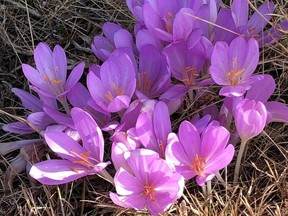Lifestyle
Gardening Insights: Tips for Managing Colchicum Bulbs and More

As autumn approaches, many gardeners are turning their attention to their flower beds and the maintenance of established plants. One reader inquired about the optimal time to separate their well-established Colchicum bulbs, commonly known as autumn crocus or naked ladies. This particular query highlights the unique beauty of these bulbs, which bloom in September or October, adding vibrant purple flowers to gardens as other plants begin to fade.
Colchicum, despite its deceptive name, belongs to the lily family and is recognized for its striking blooms that emerge from leafless stems. These bulbs are often a bit more expensive than traditional varieties, but many gardeners consider them a worthwhile investment for their seasonal impact. To ensure healthy growth, it is advisable to wait until the flowers have completed their blooming cycle before separating the bulbs. At that point, carefully dig out the entire clump and gently separate the individual bulbs and bulblets.
Another gardening enthusiast shared their experience with sunflowers, reporting a flourishing garden created by local birds. However, with the sunflower heads ripened but seemingly unappealing to the birds, the reader sought advice on enhancing their attractiveness for winter feeding.
In response, it was suggested to elevate the sunflower heads by cutting them off and placing them face-up on a fence or any high surface. This method not only makes the seeds more accessible to birds but also discourages cats from preying on them. Such practical tips can help ensure that gardens continue to thrive even in the colder months.
Gardeners dealing with blight issues also raised concerns about the potential for soil contamination. One reader inquired about the best practices following severe blight in both tomato and potato plants, which necessitated their removal. The Government of Alberta Department of Agriculture and Rural Development provides crucial insights here, noting that the late blight pathogen typically does not survive through winter unless infected potatoes are left underground or stored improperly.
To mitigate the risk of future infections, it is essential to clean up any remaining debris from the previous season. The advice indicates that while the pathogen may not survive long without living tissue, it can still pose a risk if proper cleanup is not conducted. Gardeners planning to replant in the same area next spring should be diligent in removing any leftover crops to minimize the chances of recurrence.
For those seeking further guidance, the “Growing Things Outdoors” column, authored by Gerald Filip, regularly addresses various gardening inquiries and can be accessed through the Edmonton Journal website. Readers are encouraged to engage by emailing their questions or exploring past articles to enhance their gardening knowledge.
By embracing the advice provided, gardeners can better prepare their plots for the changing seasons, ensuring a vibrant display even as the weather turns colder.
-

 Politics4 weeks ago
Politics4 weeks agoSecwepemc First Nation Seeks Aboriginal Title Over Kamloops Area
-

 World5 months ago
World5 months agoScientists Unearth Ancient Antarctic Ice to Unlock Climate Secrets
-

 Entertainment5 months ago
Entertainment5 months agoTrump and McCormick to Announce $70 Billion Energy Investments
-

 Science5 months ago
Science5 months agoFour Astronauts Return to Earth After International Space Station Mission
-

 Lifestyle5 months ago
Lifestyle5 months agoTransLink Launches Food Truck Program to Boost Revenue in Vancouver
-

 Technology3 months ago
Technology3 months agoApple Notes Enhances Functionality with Markdown Support in macOS 26
-

 Lifestyle3 months ago
Lifestyle3 months agoManitoba’s Burger Champion Shines Again Amid Dining Innovations
-

 Top Stories2 months ago
Top Stories2 months agoUrgent Update: Fatal Crash on Highway 99 Claims Life of Pitt Meadows Man
-

 Politics4 months ago
Politics4 months agoUkrainian Tennis Star Elina Svitolina Faces Death Threats Online
-

 Sports5 months ago
Sports5 months agoSearch Underway for Missing Hunter Amid Hokkaido Bear Emergency
-

 Politics5 months ago
Politics5 months agoCarney Engages First Nations Leaders at Development Law Summit
-

 Technology5 months ago
Technology5 months agoFrosthaven Launches Early Access on July 31, 2025









